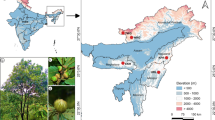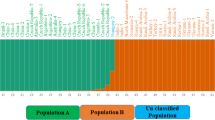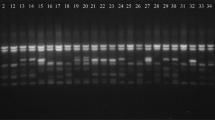Abstract
Genetic polymorphism was investigated in Thlaspi caerulescens J. & C. Presl at 15 gene regions, of which seven have been identified to putatively play a role in heavy-metal tolerance or hyperaccumulation. Single nucleotide and length polymorphisms were assessed at four cleaved amplified polymorphic sequences (CAPS) and 11 simple sequence repeat (microsatellite) loci, respectively. The utility of these loci for genetic studies in T. caerulescens was measured among seven natural populations (135 individuals). Fourteen loci rendered polymorphism, and the number of alleles per locus varied from 2 to 5 and 1 to 27 for CAPS and microsatellites, respectively. Up to 12 alleles per locus were detected in a population. The global observed heterozygosity per population varied between 0.01 and 0.31. Additionally, cross-species/genera amplification of loci was investigated on eight other Brassicaceae (five individuals per population). Overall, 70% of the cross-species/genera amplifications were successful, and among them, more than 40% provided intraspecific polymorphisms within a single population. This indicates that such markers may, as well, allow comparative population genetic or mapping studies between and within several Brassicaceae, particularly for genes involved in traits such as heavy-metal tolerance and/or hyperaccumulation.
Similar content being viewed by others
References
Assunçao AGL, Schat H, Aarts MGM (2003a) Thlaspi caerulescens, an attractive model species to study heavy metal hyperaccumulation in plants. New Phytol 159:351–360
Assunçao AGL, Ten Bookum WM, Nelissen HJM, Vooijs R, Schat H, Ernst WHO (2003b) A cosegregation analysis of zinc (Zn) accumulation and Zn tolerance in the Zn hyperaccumulator Thlaspi caerulescens. New Phytol 159:383–390
Assunçao AGL, Pieper B, Vromans J, Lindhout P, Aarts MGM, Schat H (2006) Construction of a genetic linkage map of Thlaspi caerulescens and quantitative trait loci analysis of zinc accumulation. New Phytol 170:21–32
Basic N, Keller C, Fontanillas P, Vittoz P, Besnard G, Galland N (2006a) Cadmium hyperaccumulation and reproductive traits in natural Thlaspi caerulescens populations. Plant Biol 8:64–72
Basic N, Salamin N, Keller C, Galland N, Besnard G (2006b) Genetic differentiation of Thlaspi caerulescens natural populations in relation to their cadmium hyperaccumulation capacity. Biochem Syst Ecol 34: DOI 10.1016/j.bse.2006.04.001
Beaumont MA, Nichols RA (1996) Evaluating loci for use in the genetic analysis of population structure. Proc Roy Soc Lond Ser B 263:1619–1626
Belkhir K, Borsa P, Chikhi L, Raufaste N, Bonhomme F (2004) GENETIX 4.03, logiciel sous Windows™ pour la génétique des populations. Laboratoire Génome, Populations, Interactions CNRS UMR 5000, Université de Montpellier II, Montpellier (France). http://www.univ-montp2.fr/∼genetix/genetix/genetix.htm
Bernard C, Roosens N, Czernic P, Lebrun M, Verbruggen N (2004) A novel CPx-ATPase from the cadmium hyperaccumulator Thlaspi caerulescens. FEBS Lett 569:140–148
Bert V, Meerts P, Saumitou-Laprade P, Salis P, Gruber W, Verbruggen N (2003) Genetic basis of Cd tolerance and hyperaccumulation in Arabidopsis halleri. Plant Soil 249:9–18
Boivin K, Acarkan A, Mbulu RS, Clarenz O, Schmidt R (2004) The Arabidopsis genome sequence as a tool for genome analysis in Brassicaceae: a comparison of the Arabidopsis thaliana and Capsella rubella genomes. Plant Physiol 135:735–744
Bon MC, Hurard C, Gaskin J, Risterucci AM (2005) Polymorphic microsatellite markers in polyploidy Lepidium draba L. ssp. draba (Brassicaceae) and cross-species amplification in closely related taxa. Mol Ecol Notes 5:68–70
Bovet L, Eggmann T, Meylan-Bettex M, Polier J, Kammer P, Marin E, Feller U, Martinoia E (2003) Transcript levels of AtMRPs after cadmium treatment: induction of AtMRP3. Plant Cell Environ 26:371–381
Clauss MJ, Cobban H, Mitchell-Olds T (2002) Cross-species microsatellite markers for elucidating population genetic structure in Arabidopsis and Arabis (Brassicaeae). Mol Ecol 11:591–601
Dubois S, Cheptou PO, Petit C, Meerts P, Poncelet M, Vekemans X, Lefèbvre C, Escarré J (2003) Genetic structure and mating systems of metallicolous and nonmetallicolous populations of Thlaspi caerulescens. New Phytol 157:633–641
Durka W, Bossdorf O, Gautschi B (2004) Isolation and characterization of microsatellite loci in the invasive Alliaria petiolata (Brassicaceae). Mol Ecol Notes 4:173–175
Flint-Garcia SA, Thornsberry JM, Buckler IV ES (2003) Structure of linkage disequilibrium in plants. Annu Rev Plant Biol 54:357–374
Frerot H, Petit C, Lefebvre C, Gruber W, Collin C, Escarré J (2003) Zinc and cadmium accumulation in controlled crosses between metallicolous and nonmetallicolous populations of Thlaspi caerulescens (Brassicaceae). New Phytol 157:643–648
Goudet J (2001) FSTAT, a program to estimate and test gene diversities and fixation indices (version 2.9.3). Available from http://www.unil.ch/izea/softwares/fstat.html
Gupta PK, Rustgi S, Kulwal PL (2005) Linkage disequilibrium and association studies in higher plants: present status and future prospects. Plant Mol Biol 57:461–485
Koch M, Mummenhoff K, Hurka H (1998) Systematics and evolutionary history of heavy metal tolerant Thlaspi caerulescens in Western Europe: evidence from genetic studies based on isozyme analysis. Biochem Syst Ecol 26:823–838
Koch M, Haubold B, Mitchell-Olds T (2001) Molecular systematics of the Brassicaceae: evidence from coding plastidic matK and nuclear Chs sequences. Am J Bot 88:534–544
Kuittinen H, Aguadé M, Charlesworth D, Haan ADE, Lauga B, Mitchell-Olds T, Oikarinen S, Ramos-Onsins S, Stranger B, Van Tienderen P, Savolainen O (2002) Primers for 22 candidate genes for ecological adaptations in Brassicaceae. Mol Ecol Notes 2:258–262
Lakshmi PK, Arumugam N, Gupta V, Mukhopadhyay A, Sodhi YS, Pental D, Pradhan AK (2005) Mapping and tagging of seed coat colour and the identification of microsatellite markers for marker-assisted manipulation of the trait in Brassica juncea. Theor Appl Genet 111:8–14
Lasat MM, Pence NS, Garvin DF, Ebbs SD, Kochian LV (2000) Molecular physiology of zinc transport in the Zn hyperaccumulator Thlaspi caerulescens. J Exp Bot 51:71–79
Lombi E, Zhao FJ, Dunham SJ, McGrath SP (2000) Cadmium accumulation in populations of Thlaspi caerulescens and Thlaspi goesingense. New Phytol 145:11–20
Lombi E, Tearall KL, Howarth JR, Zhao FJ, Hawkesford MJ, McGrath SP (2002) Influence of iron status on cadmium and zinc uptake by different ecotypes of the hyperaccumulator Thlaspi caerulescens. Plant Physiol 128:1359–1367
Lowe AJ, Jones AE, Raybould AF, Trick M, Moule CL, Edwards KJ (2002) Transferability and genome specificity of a new set of microsatellite primers among Brassica species of the U triangle. Mol Ecol Notes 2:7–11
Lowe AJ, Moule C, Trick M, Edwards KJ (2004) Efficient large-scale development of microsatellites for marker and mapping applications in Brassica crop species. Theor Appl Genet 108:1103–1112
Lugon-Moulin N, Zhang M, Gadani F, Rossi L, Koller D, Krauss M, Wagner GJ (2004) Critical review of the science and options for reducing cadmium in tobacco (Nicotiana tabacum L.) and other plants. Adv Agron 83:111–180
Mäser P, Thomine S, Schroder JI, Waed JM, Hirschi K, Sze H, Talke IN, Amtmann A, Maathuis FJ, Sanders D, Harper JF, Tchieu J, Gribskov M, Persans MW, Salt DE, Kim SA, Guerinot ML (2001) Phylogenetic relationships within cation transporter families of Arabidopsis. Plant Physiol 126:1646–1667
Peer WA, Mamoudian M, Lahner B, Reeves RD, Murphy AS, Salt DE (2003) Identifying model metal hyperaccumulating plants: germplasm analysis of 20 Brassicaceae accessions from a wide geographical area. New Phytol 159:421–430
Pence NS, Larsen PB, Ebbs SD, Letham DL, Lasat MM, Garvin DF, Eide D, Kochian LV (2000) The molecular physiology of heavy metal transport in the Zn/Cd hyperaccumulator Thlaspi caerulescens. Proc Natl Acad Sci USA 98:9995–10000
Plieske J, Struss D (2001) Microsatellite markers for genome analysis in Brassica. I. development in Brassica napus and abundance in Brassicaceae species. Theor Appl Genet 102:689–694
Pollard AJ, Powell KD, Harper FA, Smith JAC (2002) The genetic basis of hyperaccumulation in plants. Crit Rev Plant Sci 21:539–566
Roosens N, Leplae R, Bernard C, Verbruggen N (2005) Variations in plant metallothioneins: the heavy metal hyperaccumulator Thlaspi caerulescens as a case study. Planta 222:716–729
Roosens N, Verbruggen N, Meerts P, Ximénez-Embún P, Smith JAC (2003) Natural variation in cadmium tolerance and its relationship to metal hyperaccumulation for seven populations of Thlaspi caerulescens from western Europe. Plant Cell Environ 26:1657–1672
Suzuki N, Koizumi N, Sano H (2001) Screening of cadmium-responsive genes in Arabidopsis thaliana. Plant Cell Environ 24:1177–1188
Van Oosterhout C, Hutchinson WF, Wills DPM, Shipley P (2004) MICRO-CHECKER: software for identifying and correcting genotyping errors in microsatellite data. Mol Ecol Notes 4:535–538
Van Oosterhout C, Weetman D, Hutchinson WF (2006) Estimation and adjustment of microsatellite null alleles in nonequilibrium populations. Mol Ecol Notes 6:255–256
Yang YW, Lai KN, Tai PY, Ma DP, Li WH (1999) Molecular phylogenetic studies of Brassica, Rorippa, Arabidopsis and allied genera based on the internal transcribed spacer region of 18S–25S rDNA. Mol Phylogenet Evol 13:455–462
Zha HG, Jiang RF, Zhao FJ, Vooijs R, Schat H, Barker JHA, McGrath SP (2004) Co-segregation analysis of cadmium and zinc accumulation in Thlaspi caerulescens interecotypic crosses. New Phytol 163:299–312
Acknowledgments
The authors thank N. Salamin and L. Bovet for methodological advices, D. Savova-Bianchi and C. Parisod for technical helps and C. Keller for providing plant material from Ganges and Prayon.
Author information
Authors and Affiliations
Corresponding author
Rights and permissions
About this article
Cite this article
Basic, N., Besnard, G. Gene polymorphisms for elucidating the genetic structure of the heavy-metal hyperaccumulating trait in Thlaspi caerulescens and their cross-genera amplification in Brassicaceae. J Plant Res 119, 479–487 (2006). https://doi.org/10.1007/s10265-006-0011-x
Received:
Accepted:
Published:
Issue Date:
DOI: https://doi.org/10.1007/s10265-006-0011-x




